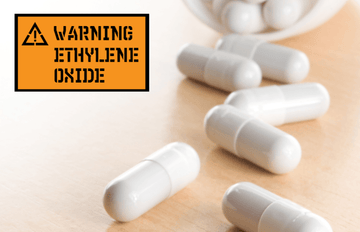Tlenek etylenu to wysoce reaktywny związek organiczny, wykorzystywany głównie do produkcji innych chemikaliów. Jest również stosowany do sterylizacji sprzętu medycznego. Tlenek etylenu jest udowodnionym czynnikiem rakotwórczym i mutagennym, a narażenie na jego działanie może prowadzić do poważnych problemów zdrowotnych. Aby zminimalizować ryzyko uszkodzenia zdrowia, w wielu krajach zakazano stosowania tlenku etylenu w żywności lub suplementach diety.
Z własnego doświadczenia możemy potwierdzić, że problem zanieczyszczonych kapsułek w Unii Europejskiej istnieje. Limity pozostałości tlenku etylenu są przekroczone w mniej więcej co trzeciej kapsułce. Niestety większość dostawców nie zajmuje się tym problemem. Konsumenci mogą zmniejszyć ryzyko narażenia na tlenek etylenu, kupując suplementy diety z zaufanych źródeł. Producenci ci gwarantują bezpieczeństwo swoich produktów, które mogą być narażone na potencjalne zanieczyszczenie, poprzez niezależne testy.
Więcej informacji na temat zanieczyszczenia żywności i suplementów tlenkiem etylenu można znaleźć w tym artykule.
Krótki przegląd artykułu:
- Co to jest tlenek etylenu?
- Toksyczność tlenku etylenu
- Historia stosowania tlenku etylenu w przemyśle spożywczym
- Zanieczyszczenie produktów spożywczych tlenkiem etylenu w UE
- Tlenek etylenu i suplementy diety
- Trime = gwarancja suplementów wolnych od EtO
Co to jest tlenek etylenu?
Tlenek etylenu to związek organiczny o wzorze (C2H4O ) , który jest wykorzystywany do produkcji różnych chemikaliów i produktów konsumenckich, takich jak detergenty, rozpuszczalniki lub tworzywa sztuczne. Tlenek etylenu to środek dezynfekujący powierzchnie, szeroko stosowany w szpitalach i przemyśle sprzętu medycznego.
Toksyczność tlenku etylenu
Tlenek etylenu jest substancją bardzo toksyczną. Międzynarodowa Agencja Badań nad Rakiem (IARC) klasyfikuje go jako udowodniony czynnik rakotwórczy. Europejska Agencja Chemikaliów klasyfikuje tlenek etylenu jako mutagen, czynnik rakotwórczy i substancję działającą toksycznie na układ rozrodczy. [1]
Tlenek etylenu może powodować podrażnienie dróg oddechowych, bóle głowy, wymioty lub zmęczenie. Długotrwała ekspozycja może powodować uszkodzenie mózgu, zmniejszenie wrażliwości palców, zaburzenia koordynacji ruchowej lub uszkodzenie wątroby i nerek.
Historia stosowania tlenku etylenu w przemyśle spożywczym
Historycznie tlenek etylenu stosowano w przemyśle spożywczym ze względu na jego właściwości dezynfekujące bez konieczności stosowania obróbki cieplnej, jako tzw. fumigant (= lotna substancja chemiczna stosowana w stanie gazowym w celu niszczenia mikroorganizmów i szkodników).
Jednakże w dużej części świata, w tym w Europie, zaprzestano fumigacji żywności i miejsc jej przechowywania tlenkiem etylenu. Unia Europejska zakazała stosowania tej substancji w 1991 roku ze względu na jej wysoką toksyczność. Rozporządzenie Parlamentu Europejskiego i Rady (WE) nr 396/2005 ustaliło maksymalne limity pozostałości tlenku etylenu w produktach spożywczych na 0,05 mg/kg. [1]
Przepisy dotyczące tlenku etylenu w wielu krajach, w tym w Kanadzie, USA i Indiach, znacznie różnią się od opisanej praktyki w Unii Europejskiej. Wymienione kraje dopuszczają stosowanie tlenku etylenu jako fumigantu żywności w walce z grzybami i niepożądanymi bakteriami. Mogą one również wykorzystywać tlenek etylenu do dezynfekcji kontenerów towarowych i magazynów.
Produkty sprowadzane z tych krajów do UE mogą zostać zanieczyszczone niedopuszczalnym poziomem tlenku etylenu podczas przechowywania i transportu.
Zanieczyszczenie produktów spożywczych tlenkiem etylenu w UE
We wrześniu 2020 r. Belgia po raz pierwszy zaalarmowała za pośrednictwem systemu RASFF (Rapid Alert System for Food and Feeds) o obecności niedopuszczalnych ilości tlenku etylenu w nasionach sezamu importowanych z Indii. Stwierdzono, że poziom tlenku etylenu przekroczył dopuszczalny limit ponad 1000 razy. [1]
Było to pierwsze z wielu tego typu ostrzeżeń. Od września 2020 r. w Unii Europejskiej wycofano z obrotu tysiące produktów spożywczych z powodu zanieczyszczenia tą rakotwórczą substancją toksyczną.
Były to głównie suche produkty spożywcze o długim terminie przydatności, takie jak zioła, przyprawy, zboża lub produkty zawierające dodatki takie jak guma ksantanowa (E415), karubin (E410) lub guma guar (E412).
Tlenek etylenu i suplementy diety
W 2021 roku ogłoszono alert RASFF dotyczący zanieczyszczenia węglanu wapnia tlenkiem etylenu. Węglan wapnia jest stosowany nie tylko jako dodatek do żywności, ale jest również szeroko stosowany w suplementach diety i kapsułkach nutraceutycznych jako substancja pomocnicza.
W odpowiedzi na rosnące przypadki zanieczyszczenia dodatków do żywności, Komisja Europejska ustaliła limit 0,1 mg/kg dla obecności tlenku etylenu w dodatkach do żywności. Zasada ta dotyczy również tlenku etylenu używanego do produkcji kapsułek suplementów diety. W przypadku przekroczenia limitu zawartości tlenku etylenu, produkty objęte zakazem muszą zostać wycofane z obrotu i wycofane od konsumentów.
Trime = gwarancja suplementów wolnych od EtO
Ryzyko związane z toksycznym tlenkiem etylenu można zmniejszyć, wybierając zaufanych producentów lub dostawców. Najlepiej w połączeniu z gwarancją testowania produktów narażonych na potencjalne zanieczyszczenie tlenkiem etylenu. Najlepiej przeprowadzać testy na surowcach, a nie na produktach gotowych, które w przypadku udowodnionego zanieczyszczenia muszą zostać wycofane z rynku.
Czystość i wysoka jakość produktów Trime są dla nas kluczowe i nie jesteśmy obojętni na potencjalne ryzyko zanieczyszczenia toksycznym tlenkiem etylenu. W praktyce niestety często spotykaliśmy się z przekroczeniami limitów pozostałości tlenku etylenu. Z tego powodu zdecydowaliśmy się na przeprowadzenie własnej analizy, która gwarantuje, że kapsułki stosowane w naszych suplementach są tzw. „wolne od tlenku etylenu”.
Źródła
[1] https://esipa.cz/sbirka/sbsrv.dll/sb?DR=SB&CP=32020R1540
https://cs.wikipedia.org/wiki/Ethylenoxid
https://food.ec.europa.eu/system/files/2021-12/rasff_ethylene-oxide-incident_e410_crisis-coord_20211004_sum.pdf
https://www.safefood.net/food-safety/news/oxide-ethylene-oxide

















